The Delhi Sultanate Chapter Notes | History Class 9 ICSE PDF Download
The Delhi Sultanate (AD 1206–1526) was a major period in Indian history when Turks ruled North India from Delhi. After the 10th century, India’s divided kingdoms allowed Turks to take control. Five dynasties—Slave, Khilji, Tughlaq, Sayyid, and Lodi—governed, bringing changes in administration, architecture, and culture. Famous works like Tarikh-i-Firozshahi and monuments like Qutub Minar show their impact.
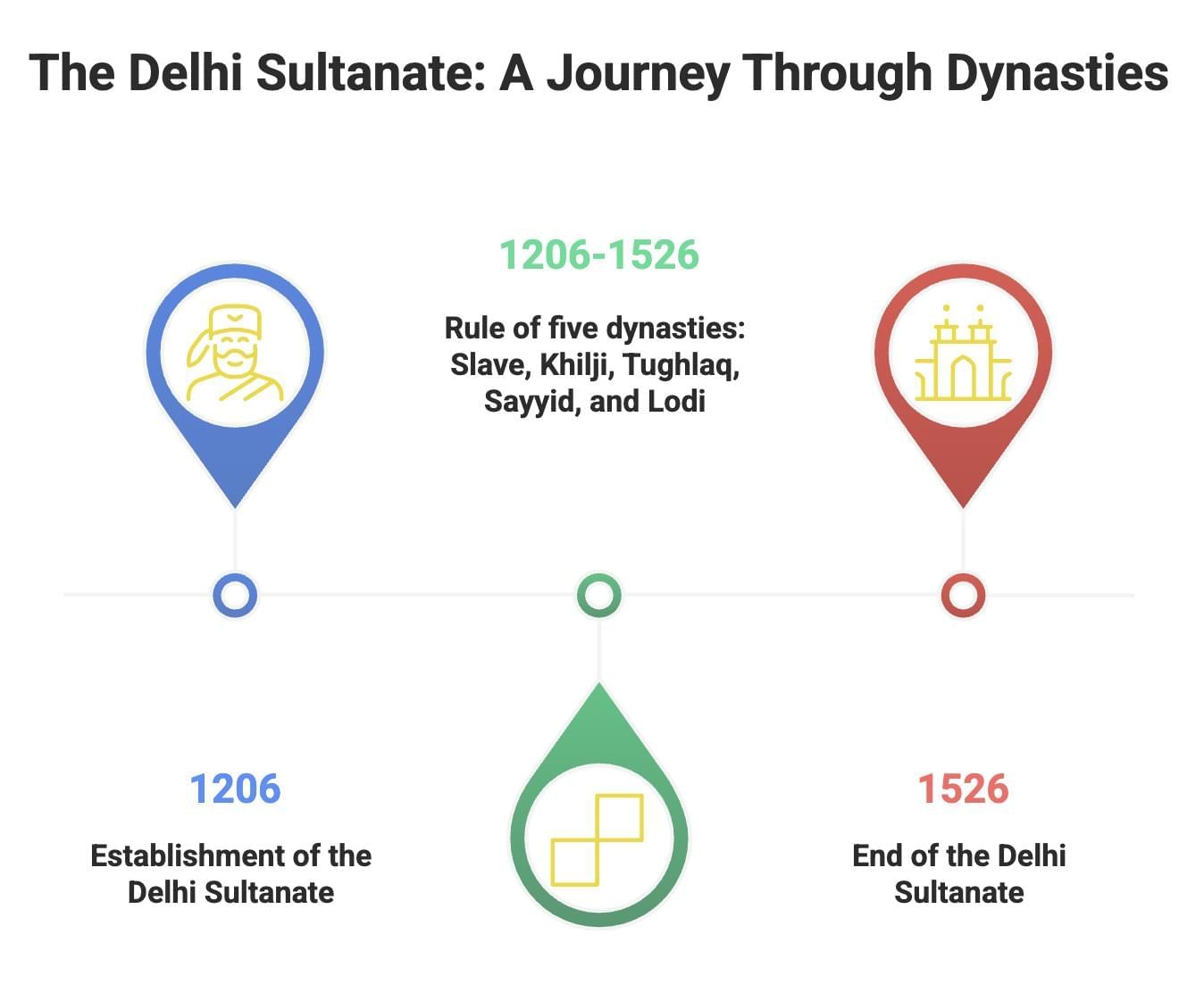
The Delhi Sultanate
- By the 10th century, North India was divided into warring kingdoms, creating a political vacuum.
- Turks exploited this, establishing rule in Delhi by the 12th century.
- Expanded their kingdom over the next century by conquering other Indian states.
- Ruled North India from AD 1206 to AD 1526, known as the Delhi Sultanate, with Delhi as the capital.
- Kings were called Sultans.
Sources
Literary Sources
Biographies, autobiographies, court histories, chronicles, foreign travellers’ accounts, and private correspondence provide historical information.Key works include:
- Tarikh-i-Firozshahi by Ziauddin Barni.
- Tarikh-i-Mubarakshahi by Yahya-bin-Ahmed.
- Tabaqat-i-Nasiri by Minhaj-us-Siraj.
- Khazain-ul-Futuh by Amir Khusrao.
- Tughlaqnama by Amir Khusrao.
- Prithvirajraso by Chand Bardai.
- Tarikh-i-Firozshahi by Ziauddin Barni details the political, social, and economic conditions of medieval India.
- Prithvirajraso, an epic poem by Chand Bardai, narrates Prithviraj Chauhan’s heroic deeds (ruler of Ajmer and Delhi, AD 1165–1192).
- Prithvirajraso offers insights into socio-political conditions and Kshatriya social and clan structures, though it inaccurately describes the battle between Muhammad Ghori and Prithviraj Chauhan.
Architecture
- Monuments and coins are key sources.
- Inscriptions on coins, monuments, milestones, and tombstones, in Sanskrit or Arabic, provide details.
- Example: Bakhtiya Khilji’s first coins had both Arabic and Sanskrit inscriptions.
- Monuments reveal living conditions, faiths, beliefs, and technological advancements.
- Turkish architectural features included domes, minarets, arches, and pointed roofs.
- Notable monuments:
- Quwat-ul-Islam Mosque and Qutub Minar by Qutb-ud-din Aibak in Delhi.
- Adhai din ka Jhompara by Qutb-ud-din Aibak in Ajmer.
- Iltutmish’s tomb by Iltutmish.
- Alai Darwaza, Siri Fort, Hauz Khas, and Zamat Khana Masjid by Alauddin Khilji in Delhi.
- Qutub Minar, a major medieval structure, was started by Qutb-ud-din Aibak and completed by Iltutmish.
- Qutub Minar features:
- Original height: 7.14 meters with four storeys; later, a fifth storey was added.
- Circular tower, 13.5-meter diameter, with 379-step circular stairway to the top.
- Each tower has a projecting balcony.
- Inscribed with Quranic verses.
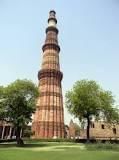
Muhammad Ghori
- Ascended the throne at Ghazni in 1173, aiming to build an empire in India.
- Unlike Mahmud of Ghazni, who raided but did not control North India, Ghori sought territorial control.
- Prithviraj Chauhan of the Chauhan dynasty ruled Delhi and Ajmer in the late 12th century.
- Conflict with Prithviraj was inevitable due to Ghori’s expansionist ambitions.
- First Battle of Tarain (1191): Prithviraj defeated Ghori’s forces.
- Second Battle of Tarain (1192): Ghori defeated Prithviraj, establishing control over Delhi and Ajmer.
- Prithviraj may have ruled Ajmer briefly under Ghori, as coins with both their names exist.
- Battle of Chandwar (1194): Ghori defeated Jaichandra of Kannauj, killed in battle, extending Turkish control to Bihar’s boundaries.

Factors Leading to the Defeat of the Rajputs
Rajputs, despite bravery, lost key battles to the Turks due to:
- Division into numerous clans prioritising family traditions, lacking unity against the Turks.
- Turks faced individual dynasties, not a unified Rajput army.
- Turkish cavalry used superior, swift horses; Rajputs relied on slower elephants.
- Turks had multiple military leaders using new tactics; Rajputs excelled with spears and swords but were less skilled as archers.
List of various dynasties and important rulers of the Delhi Sultanate
Five dynasties ruled Delhi: Slave, Khilji, Tughlaq, Sayyid, and Lodi.
Rulers and periods:
- Qutb-ud-din Aibak (Slave, 1206–1210).
- Shamsuddin Iltutmish (Slave, 1210–1236).
- Razia (Slave, 1236–1240).
- Ghiyasuddin Balban (Slave, 1266–1287).
- Jalaluddin Khilji (Khilji, 1290–1296).
- Alauddin Khilji (Khilji, 1296–1316).
- Ghiyasuddin Tughlaq (Tughlaq, 1320–1324).
- Muhammad bin Tughlaq (Tughlaq, 1325–1351).
- Firoz Shah Tughlaq (Tughlaq, 1351–1388).
- Khizr Khan (Sayyid, 1414–1421).
- Bahlul Lodi (Lodi, 1451–1489).
- Sikandar Lodi (Lodi, 1489–1517).
- Ibrahim Lodi (Lodi, 1517–1526).
The Slave Dynasty
- First of the five Delhi Sultanate dynasties.
Qutb-ud-din Aibak
- Appointed by Muhammad Ghori as the Governor of the Indian provinces after annexing North India.
- Founded the Slave (Mamluk) Dynasty, as sultans were former slaves or their sons.
- Captured forts of Kalinjar (Bundelkhand) and Anhilwara (Gujarat).
- Died from a fall while playing polo.

Iltutmish
- Succeeded Aram Shah, Qutb-ud-din Aibak’s incapable son, whom he overthrew.
- Defeated enemies and suppressed revolts.
- Tactically denied refuge to Iran’s ruler Jalaluddin in 1221, avoiding a Mongol attack by Chenghez Khan.
- Formed ‘Turkan-i-Chahalgani’ or ‘Chalisa,’ a group of 40 elite nobles, to curb the court nobles’ power.
- Divided the empire into iqtas (land grants), sometimes given to nobles or commanders instead of salaries.
- Introduced silver tanka and copper jital as standard coins.
Razia Sultan
- First woman Sultan of Delhi, ruling from 1236 after Iltutmish’s death.
- Faced opposition from Turkish nobles unwilling to accept a female ruler, preferring a puppet king.
- Razia dressed as a man, led armies, held open court, avoided purdah, and supervised all departments.
- Failed to suppress revolts by provincial governors.
- Married rebel leader Altunia to pacify opposition, but both were killed in 1240.
- Weak rulers followed, unable to strengthen the empire.
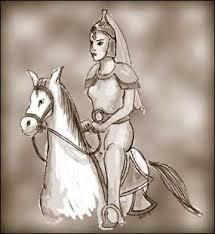 Balban, a powerful noble, became Sultan in 1266, suppressing nobles and strengthening the monarchy.
Balban, a powerful noble, became Sultan in 1266, suppressing nobles and strengthening the monarchy.
The Khilji Dynasty
- Founded by Jalaluddin Khilji after the Slave Dynasty’s end.
Jalaluddin Khilji
- Founded the Khilji Dynasty after killing Kaikubad, the last Slave Dynasty ruler.
- Rewarded nobles who supported his ascension.
- Faced opposition from Turkish nobles seeking power.
- Known for a mild and pious nature, granting high posts to friends, relatives, and supporters.
- Murdered by his nephew, Alauddin Khilji, in 1296, who became Sultan.
Alauddin Khilji
- Famous for economic measures and southern expeditions.
- Massacred Mongols in Delhi who had converted to Islam to prevent Mongol attacks.
- Expanded empire by conquering Ujjain, Dhar, Chanderi, and Mandu; annexed most of North India by 1305.
- Built a strong army, paying soldiers in cash.

Market Regulations
- Fixed prices for essentials like food grains, sugar, and cooking oil.
- Established three Delhi markets: one for food grains, one for expensive clothes, and one for horses, slaves, and cattle.
- Each market is managed by a Shahna (market controller).
- Shopkeepers faced strict punishments for cheating or underweighing goods.
Deccan Expeditions
- First Muslim Sultan to conquer North India and send expeditions south under Malik Kafur.
- Defeated Dwar Samudra, Warangal, Devagiri, and Madurai.
- Allowed defeated rulers to govern in exchange for regular tribute, not annexing their states.
- Sought Deccan wealth to fund his army, avoiding control of the rugged terrains.
Measures against Nobility
- Forbade nobles from hosting parties or intermarrying without the Sultan’s permission to prevent conspiracies.
- Banned gambling, nobles’ private armies, and wine drinking.
- Established an efficient spy system to monitor nobles’ activities inside and outside their homes.
- Revoked previous rulers’ land grants; new grants allowed revenue collection but not additional peasant taxes.
Military Reforms
- Established a permanent standing army, a first for the Delhi Sultans.
- Introduced chehre (soldier descriptive rolls) and dagh (horse branding).
- Built new forts and repaired old ones.
- Employed spies in army units.
- Paid soldiers regular cash salaries.
Revenue Reforms
- Measured land to fix state taxes, increasing revenue from one-third to half, payable in cash.
- Appointed revenue officers to collect taxes.
- Reforms funded a large army.
The Tughlaq Dynasty
Began when Ghiyas-ud-din Tughlaq, Dipalpur’s Governor, became Sultan, ending the Khilji Dynasty.
Muhammad bin Tughlaq
- Succeeded Ghiyas-ud-din Tughlaq, a scholar of Persian literature, music, arts, and calligraphy.
- Known for failed schemes.
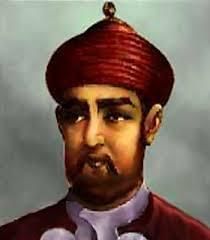
Transfer of Capital
- Central location, equidistant from key places.
- Safety from Mongol attacks, as Delhi was vulnerable.
- Ordered most Delhi residents to relocate to Daulatabad, causing resentment.
- The 1,500 km journey was harsh; many died, and survivors struggled to adapt.
- Delhi became vulnerable to Mongol attacks without the king.
- Later, shifted capital was shifted back to Delhi.
Token Currency
- Issued copper coins valued equal to silver coins due to silver scarcity.
- Copper coins lacked complex designs, making them easy to forge.
- People minted fake coins at home, flooding markets.
- Traders and merchants refused copper coins, halting the economy.
- Replaced copper coins with silver, draining the treasury.
Example: Muhammad bin Tughlaq’s token currency failed because forged copper coins, made by common people, were indistinguishable from official ones, causing merchants to lose trust, similar to how counterfeit money today disrupts trade.
Taxation in Doab
- Increased taxes in the Doab (fertile region between the Ganga and Yamuna) to fund a large army.
- The tax hike coincided with a severe famine.
- Tax collectors ruthlessly enforced payments, driving peasants to abandon their lands and flee to the forests.
- Later introduced relief measures like free kitchens and grain distribution were introduced, but agriculture suffered greatly.
Plan of Conquests
- Aimed to conquer Khurasan, Persia, and Iraq, forming a strong army with a year’s advance salary.
- Abandoned plans due to financial crises from failed taxation and token currency schemes.
- Disbanded the army.
Firoz Shah Tughlaq
- Succeeded Muhammad bin Tughlaq.
- Gained support from nobles and Ulemas by granting lands.
- Established manufacturing centres called karkhanas.
- Built roads and canals.
- Created a charity department to aid the poor and needy.
- Set up a department to manage the slaves’ conditions.
- Died in 1388; the empire began disintegrating afterwards.
- Timur invaded India in 1398 during Tughlaq rule, defeating the Sultanate army and massacring Delhi’s residents.
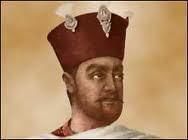
The Sayyid Dynasty
- Founded by Khizr Khan after Timur’s departure from Delhi.
- Followed by weak rulers: Mubarak II, Muhammad Shah, and Ala-ud-Din Shah.
- These kings achieved little for their regions.
The Lodhi Dynasty
- The Afghan dynasty ruled Delhi for about 75 years.
- Key rulers: Bahlul Lodi, Sikandar Lodi, Ibrahim Lodi.
- Authority limited to Delhi and the surrounding areas.
- Ended when Ibrahim Lodi was defeated by Babur in the First Battle of Panipat in 1526.
Administration of the Delhi Sultanate
- Highly centralised, with the Sultan holding executive, legislative, and judicial powers.
- Sultan, aided by ministers, Wazir (Prime Minister) supervised other ministers.
- Ariz-i-mumalik managed army recruitment, equipment, and payments; the Sultan was commander-in-chief.
- Key departments: diwan-i-risalat (religious matters) and diwan-i-insha (state correspondence).
- The empire was divided into provinces called iqtas, managed by a muqti.
- Provinces were split into paranganas (districts).
- Village administration involved:
- Muqaddam (village headman).
- Patwari (land record keeper).
- Mushrif (village accountant).
- Village panchayat for dispute resolution.
- Iqta system: Revenue grants from territories given to iqtadars, who maintained troops for the Sultan and paid soldiers from iqta revenues.
Example: Under the iqta system, an iqtadar might collect taxes from a province’s villages to pay his soldiers, ensuring the Sultan had a ready army without directly managing local finances.
Social Life
Significant income inequalities: nobles lived luxuriously, while the poor faced hardships.
Hindu society remained unchanged, following a rigid caste system:
- Brahmins enjoyed privileges.
- Kshatriyas protected the kingdom and people.
- Vaishyas engaged in farming.
- Shudras, at the lowest rank, did menial work and faced oppression.
- Muslims were divided by ethnicity (Turkish, Iranian, Arab, Afghan, Abyssinian) and further by origin, religion, and occupation.
- Child marriages were common.
- Sati was practised; Sultan’s permission was required, as noted by traveller Ibn Battuta.
- Upper-caste women followed the purdah system.
|
14 videos|59 docs|16 tests
|
FAQs on The Delhi Sultanate Chapter Notes - History Class 9 ICSE
| 1. What were the main factors that led to the defeat of the Rajputs against Muhammad Ghori? |  |
| 2. Can you provide a brief overview of the dynasties that ruled during the Delhi Sultanate? |  |
| 3. What role did Muhammad Ghori play in the establishment of the Delhi Sultanate? |  |
| 4. What were some significant contributions of the Tughlaq Dynasty to the Delhi Sultanate? |  |
| 5. How did the decline of the Delhi Sultanate pave the way for the Mughal Empire? |  |




















